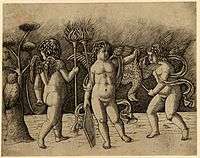Giovanni Antonio da Brescia
Giovanni Antonio da Brescia was an Italian engraver of northern Italy, active in the approximate period 1490–1519,[1] during the Italian Renaissance. In his early career he used the initials "Z.A." to sign some twenty engravings, and until recently Zoan Andrea was regarded as a distinct printmaker; it is now realized that they are the same person,[2] and the "Z.A." stood for Giovanni Antonio, "Zovanni" being a north Italian spelling. Around 1507 he began to use formulae such as "IO.AN.BX.", and signed some prints more fully.[3] The real Zoan Andrea was a very obscure painter, documented as working in Mantua in the 1470s, who produced no engravings.[4]


The newly expanded oeuvre comprises at least 150 engravings, making Giovanni Antonio one of the most prolific Italian engravers of this period.[5] A large number copy other prints, as was then common, and others are probably after drawings by Andrea Mantegna; "all his major works seem to have been based on designs by other artists" ("major" here presumably excludes the large number of ornament prints).[6]
Beginning his printmaking career in a close but uncertain relationship with the aged Andrea Mantegna (c.1431–1506) in Mantua, as some kind of pupil or collaborator, he then may have travelled around north Italy, and certainly spent his later printmaking years in Rome. He developed his technique, becoming a technical influence on other Italian engravers, notably Marcantonio Raimondi.[7]
Life
Though he was apparently from Brescia in northern Italy, there are no documentary records of his life other than the prints; the locations and rough timing of his career have been worked out from these. He began his traceable printmaking career in the circle of Mantegna, arriving in Mantua in the 1490s, and leaving around 1506, perhaps after Mantegna's death that year.[8] He may have been relatively old and experienced as an artist in another medium when he joined the aged Mantegna. It is assumed he moved to Rome, as his later engravings depict works available to him only in that city, but the date this happened varies between different accounts. After he left Mantua Benedetto Montagna and his father Bartolomeo Montagna, both of Vicenza, become influences, and a period there has been posited. He also appears to have spent time in Florence, as one print copies a drawing by Filippino Lippi.[9]
The date of his arrival in Rome is estimated to be around 1506,[10] c. 1509,[11] and "likely" by 1513.[12] One print shows the famous Roman sculpture the Laocoön Group, which was excavated in 1506.[13] According to Jacquelyn Sheehan (in 1973), he must have been active there until at least 1525, from the date of a painting he engraved,[14] but Zucker and the British Museum end his activity about 1519 or 1520; another print copies a painting of 1519.[15]
Prints
His prints are mainly concerned with the figures, which often occupy most of the picture space. Unlike many of his contemporaries, who adopted the extensive landscape backgrounds pioneered by Albrecht Dürer, he is, like Mantegna, relatively little interested in the backgrounds, which are often blank or very simple. According to Sheehan "he never achieves a true unity between figures and setting, as do the more advanced masters of the 16th century".[16]
In Mantua his relationship with Mantegna was apparently close, but the precise nature of it remains uncertain. Mantegna had been interested in printmaking for decades, probably since the 1460s, and he is "the artist who can best be claimed to have "invented" printmaking in Italy".[17]
 Christ Before Pontius Pilate
Christ Before Pontius Pilate_-_Four_Dancing_Muses_-_Google_Art_Project.jpg) Four dancing Muses
Four dancing Muses Probably the earliest print of the Laocoön Group, excavated in Rome in 1506.[18]
Probably the earliest print of the Laocoön Group, excavated in Rome in 1506.[18] Three putti
Three putti
Notes
- sometimes called "Gian Antonio..."
- Zucker, 58; BM. The evidence was published by Landau and Zucker in the catalogue for the 1992 London exhibition on Mantegna
- Zucker, 58–59; Sheehan, 235; BM
- Zucker, 59
- Zucker, 59
- Zucker, 59; Sheehan, 235–237, 237 quoted
- Landau, 76
- Sheehan, 235
- Zucker, 59; Sheehan, 235–236, 236 quoted; BM
- Implied in Zucker, 59, who mentions no stops on the way
- BM
- Sheehan, 236
- Zucker, 59
- Sheehan, 236
- Zucker, 59; BM
- Sheehan, 236
- Landau, 65
- British Museum collection database
References
- "BM", British Museum, biographical details
- AM Hind (1923), A History of Engraving and Etching, 1923, Houghton Mifflin Co., reprinted Dover Publications, 1963, ISBN 0486209547
- Landau, David, and Parshall, Peter. The Renaissance Print, Yale, 1996, ISBN 0300068832
- "Grove", "Giovanni Antonio da Brescia" Grove Art Online, Oxford Art Online. Oxford University Press. Web. 19 Jan. 2017, subscription required
- Sheehan, Jacquelyn L., in: Jay A. Levinson (ed.) Early Italian Engravings from the National Gallery of Art, National Gallery of Art, Washington (Catalogue), 1973, LOC 7379624
- Zucker, Mark J., in K.L. Spangeberg (ed), Six Centuries of Master Prints, Cincinnati Art Museum, 1993, ISBN 0931537150
Further reading
| Wikimedia Commons has media related to Giovanni Antonio da Brescia. |
- A. M. Hind: Early Italian Engraving: A Critical Catalogue with Complete Reproduction of All the Prints Described Vol. V (London, 1948), pp. 33–54
- M. J. Zucker: Early Italian Masters (1980), Commentary (1984), 25 [XIII/ii] of The Illustrated Bartsch, ed. W. L. Strauss (New York, 1978–)
- D. Landau and S. Boorsch (eds), Mantegna, exhibition catalogue Royal Academy and Metropolitan Museum of Art, 1992, pp.57–61